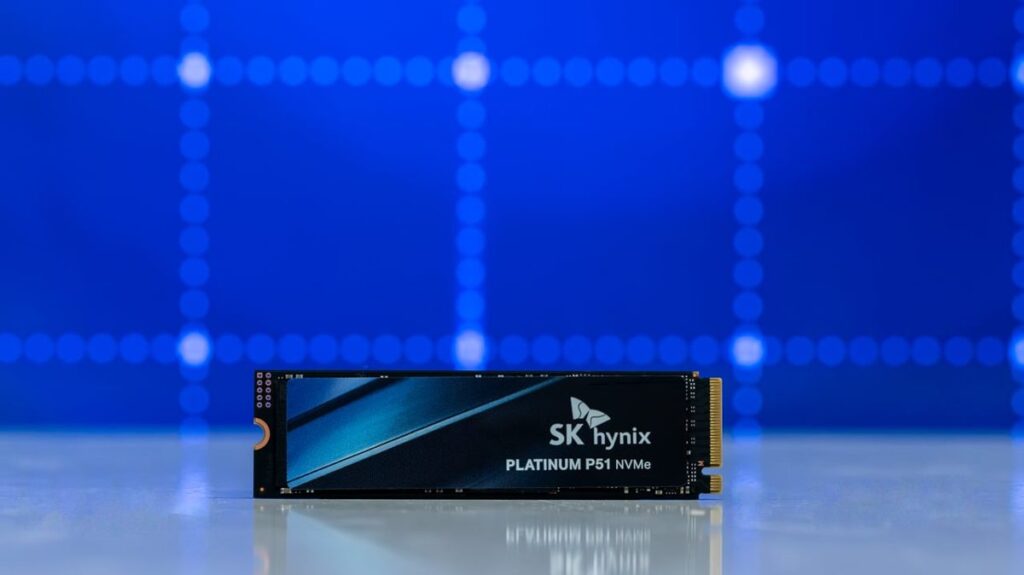
The SK Hynix Platinum P51 internal solid-state drive, priced at $199.99 for 1TB and $319.99 for 2TB, marks the South Korean chip maker’s debut in the PCI Express (PCIe) 5.0 SSD market. Leveraging in-house components, the P51 boasts impressive throughput numbers, though it falls short of the five-star WD Black SN8100, a current favorite in the PCIe 5.0 category. While the P51 is a solid performer, its appeal would be greater at a lower price point and with capacities exceeding 2TB.
Design and Components: A Homegrown Approach
The Platinum P51 is a four-lane SSD operating on the NVMe 2.0 protocol over a PCIe 5.0 bus, housed in the standard M.2 Type-2280 format. This single-sided drive utilizes SK Hynix’s own 238-layer 3D TLC (V8) NAND flash and the Hynix Alistar controller. Unlike some recent DRAM-less PCIe 5.0 drives, the P51 includes its own DRAM cache, setting it apart from competitors like the Crucial P510 and Addlink G55H, which rely on the host memory buffer (HMB) for caching.
SK Hynix has engineered the P51 with power efficiency in mind, though its maximum power consumption of 10 watts is not particularly groundbreaking. For comparison, the WD Black SN8100, an Editors’ Choice winner, consumes a maximum of 7 watts. The drive’s design underscores ongoing efforts to make PCIe 5.0 SSDs more mainstream.
It’s important to note that SK Hynix does not currently offer a version of the drive with a bundled heatsink. Users are advised to ensure their motherboard has an adequate thermal solution for the PCIe 5.0 slot, as effective heat management is crucial for optimal performance.
System Requirements: Compatibility and Considerations
To fully leverage the speed enhancements of PCIe 5.0 SSDs like the P51, users need compatible hardware. Recent high-end desktops and select laptops support PCIe 5.0, but many users may need to build or upgrade their systems. An Intel 12th Gen or later Core CPU with a Z690 or Z790 chipset motherboard, or an AMD Ryzen 7000 or 9000 CPU with an AM5 motherboard, is required.
However, having the right chipset does not guarantee PCIe 5.0 M.2 slot availability. Users should verify their motherboard’s specifications to ensure compatibility before purchasing the drive. This is crucial as some boards may only offer PCIe 5.0 slots for graphics cards, not for M.2 SSDs.
Price and Capacity: Evaluating the Offer
In a market where PCIe 5.0 SSDs reach up to 4TB and manufacturers are promising 8TB versions, the P51’s 2TB capacity seems limited. Priced between $250 and $260, it competes with premium models like the WD Black SN8100. The P51 shares a durability rating with many Gen 5 SSDs, but falls short of the ADATA Legend 970 and Seagate FireCuda 540, the latter being the durability leader.
The TBW spec is a manufacturer’s estimate of how much data can be written to a drive before some cells begin to fail. SK Hynix offers a five-year warranty or until the rated TBW is reached.
Despite its lower durability rating, the P51 is likely to last beyond the warranty period under typical usage conditions.
Performance: Speed and Benchmark Results
In performance tests, the P51 demonstrated impressive speed, aligning with its rated throughput. It ranked third in sequential read speed and second in sequential write speed during Crystal DiskMark testing. However, its 4K read and write scores were average, trailing behind the top-performing WD Black SN8100.
The PCMark 10 Overall Storage test, which simulates various routine tasks, saw the P51 achieve the fourth-highest score. It excelled in specific tests like Overwatch and Battlefield 5 but lagged in Call of Duty Black Ops 4.
On the 3DMark 10 gaming benchmark, the P51 delivered a middling performance, comparable to other Gen 5 SSDs but below the top performers, Crucial T705 and WD SN8100.
As SK Hynix ventures into the PCIe 5.0 arena, the Platinum P51 offers a glimpse of its potential in this competitive market. While it may not be the top choice for all users, it represents a significant step forward for the company, promising further innovations in the SSD space.







